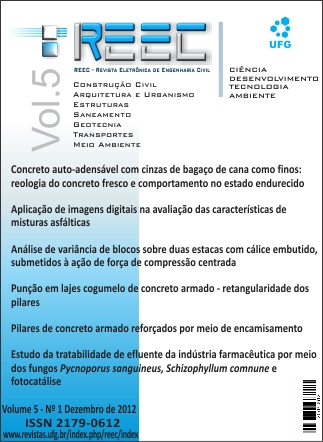Estudo da tratabilidade de efluente da indústria farmacêutica por meio dos fungos Pycnoporus sanguineus, Schizophyllum comnune e fotocatálise
DOI:
https://doi.org/10.5216/reec.v5i1.20257Resumo
RESUMO: O presente trabalho tem por objetivo avaliar a tratabilidade de um efluente da indústria farmacêutica, por meio dos fungos Pycnoporus sanguineus e Schizophyllum comnune e a fotocatálise heterogênea, usando-se o TiO2. Foram avaliadas a produção enzimática de lacase, manganês peroxidase, lignina peroxidase, a variação da Demanda Química de Oxigênio (DQO) e a toxicidade a Artemia salina. Foi usado o meio de cultura sólido ágar batata (BGA) para o crescimento dos fungos (cinco dias); contudo, houve uma variação: a substituição da água destilada pelo efluente in natura para indução enzimática. Foram realizados tratamentos biológico e combinado com fotocatálise, primeiramente tratamento biológico inicial seguido de fotocatálise e depois fotocatálise seguida de tratamento biológico. Verificou-se maior redução de 78% de DQO em 48 h de tratamento fúngico por meio de S. commune e maior produção de lacase (17,00 U mL-1) pelo P. sanguineus em 96h de tratamento fúngico. As formas combinadas apresentaram decaimento de DQO e produção enzimática menor que o tratamento biológico. Em todas as formas de tratamento não houve aumento de toxicidade para Artemia salina, indicando viabilidade ambiental para o processo de tratamento biológico. ABSTRACT: The present work intends to evaluate the tractability of a pharmaceutical effluent by Pycnoporus sanguineus, Schizophyllum commune and heterogenic photocatalysis, using TiO2 as catalyser. It was evaluated enzymatic activity of Laccase, manganese peroxidase, lignin peroxidase, chemical oxygen demand (COD) and toxicity to Artemia salina. It was used the solid culture medium with agar and potato to fungal growth (5 days), however there was a variation: the substitution of distilled water to in natura effluent to induction enzymatic. The bioremediation treatment were done with in natura effluent, sterilized effluent and induction on solid medium and the combined treatment were done with initial biologic treatment before photocatalytic treatment and the opposite of. The highest COD increasing in 48h of fungal treatment were using S. commune and the highest laccase production (17.00 U mL-1) were by Pycnoporus sanguineus in 96h of treatment and manganese peroxidase production in 24h of treatment (2.00 U mL-1). In general, the combined treatment showed COD decreasing and enzymatic production smaller than the biological treatment. In all treatment forms, there was no increasing of toxicity to Artemia salina, indicating environmental viability to biological treatment.Downloads
Não há dados estatísticos.
Downloads
Publicado
2012-10-17
Como Citar
SALES, Paulo de Tarso Ferreira; CAMPOS, Luiza Cintra; SCHIMIDT, Fernando; VALADARES, Marize Campos; SANTIAGO, Mariângela Fontes. Estudo da tratabilidade de efluente da indústria farmacêutica por meio dos fungos Pycnoporus sanguineus, Schizophyllum comnune e fotocatálise. REEC - Revista Eletrônica de Engenharia Civil, Goiânia, v. 5, n. 1, 2012. DOI: 10.5216/reec.v5i1.20257. Disponível em: https://revistas.ufg.br/reec/article/view/20257. Acesso em: 5 dez. 2025.
Edição
Seção
Saneamento e Ambiente
Licença
Autores que publicam nesta revista concordam com os seguintes termos: Autores mantém os direitos autorais e concedem à revista o direito de primeira publicação, com o trabalho simultaneamente licenciado sob a Licença Creative Commons Attribution que permite o compartilhamento do trabalho com reconhecimento da autoria e publicação inicial nesta revista.
![[REEC] Revista Eletrônica de Engenharia Civil](https://revistas.ufg.br/public/journals/30/pageHeaderLogoImage_pt_BR.png)



